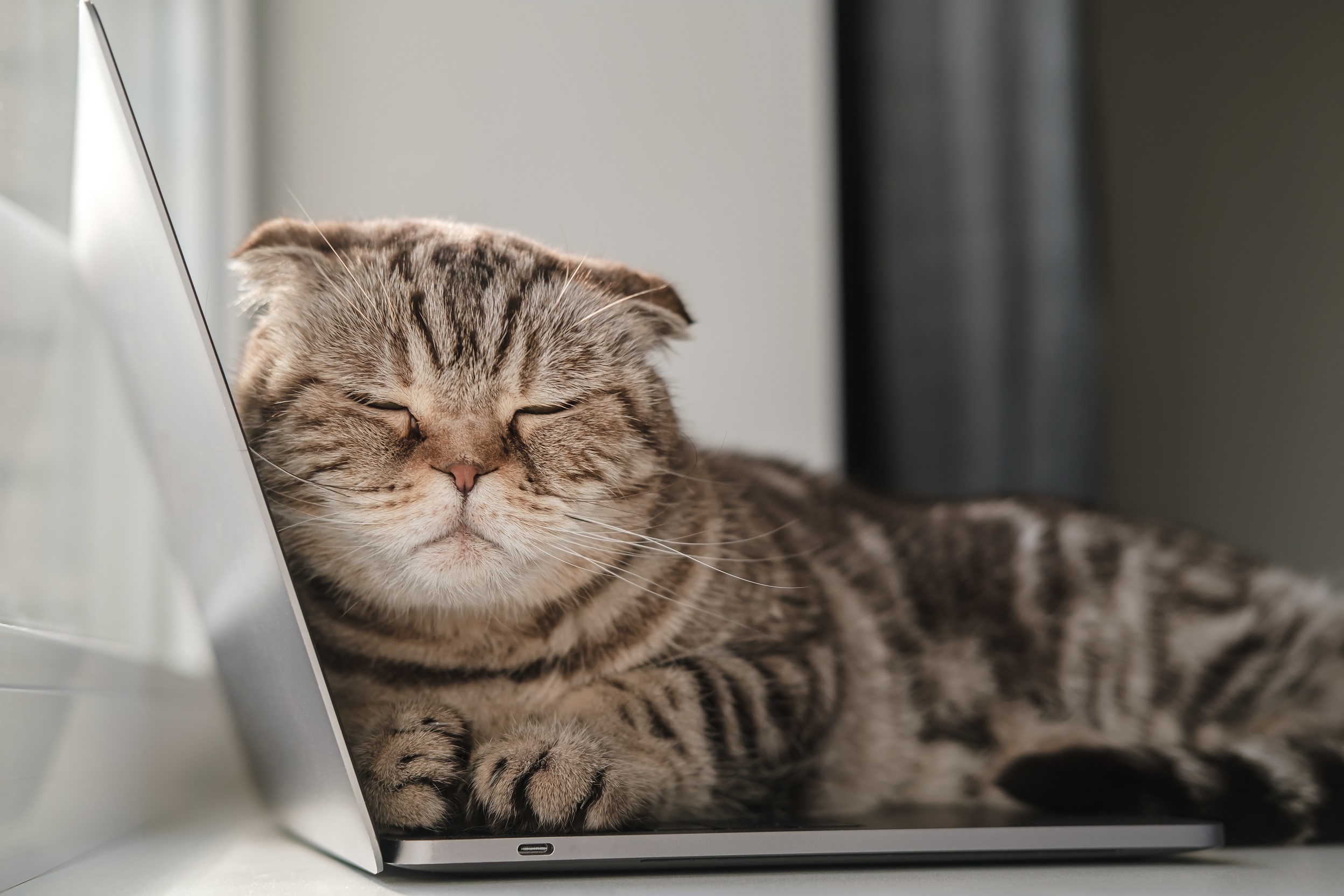Why do cats rule the Internet and technology?

“Cat to get attention” will boost any social media post. Also, for some reason, the first video sent from space to Earth was a video of a cat. It’s because these animals are a graceful object for scientists, including those in technology.
Maybe the dream of a perpetual motion machine came from observing kittens? When you look at their frantic galloping all over furniture, people, walls and nearly ceilings, it’s hard not to ask yourself: don’t they get tired at all? They look as if they are driven by some mysterious and powerful force. After all, it can’t be energy from food alone.
Perpetuum mobile. A machine that could run indefinitely. A self-propelling mechanism. Physicists say: this is impossible, incompatible with the principles of thermodynamics. Besides, the cat ultimately runs out of energy and needs rest.
They could take up the topic of “cats and entropy” themselves.
Entropy, a function of disorder. In a closed system, according to the second law of thermodynamics, it cannot decrease. This is experienced on a daily basis by cat owners and children: entropy in a closed system of an apartment increases every day!
I can has cheezburger on Catstagram
A template with two “talking” cats has recently broken records of popularity on instagram rolls. The ginger one, more talkative and a bit puzzled, is discussing with the evidently disaffected brown one, who has a short answer to all its questions. They have plenty of topics, from food to the gym. And although we’ve seen many versions, we’re watching yet another one.
More than 90,000 videos with cats are uploaded to YouTube every day. The fluffy celebrities have millions of subscribers and views (e.g. That Little Puff – 29.2 million subscribers, Shortest Video on YouTube – 46 million views). One of the most memeable cats was Tardar Sauce, known worldwide for her perpetually discontented expression as Grumpy Cat. The cat, who died in 2019, was the face of many memes and even a weather forecast app (which, of course, was always bad). It is worth mentioning two more cat memes that were extremely popular a dozen years ago. These are the famous big-eyed cat from Shrek and the demanding gray kitten, who enamored netizens just by saying “I can has cheezburger?”.
Three years ago, Australian company Budget Direct proved that cats rule Instagram. The study was simple – they compared the number of hashtags referring to dogs and cats (like #ilovemycat, #ilovemydog) around the world. What did it turn out? In 91 countries on Instagram, cats are more popular than dogs (dogs top cats in 76 countries). In New York City, which turned out to be the world’s most animal-oriented city (the most posts were published here), 59.6 percent of the photos depicted felines.
Amid so many cute photos and videos, one can lose oneself and completely lose track of time. Let us take consolation from the results of a study that researchers from the University of Indiana conducted. They showed almost seven thousand people videos with cats and checked how they affected their mood. And the impact was good: the subjects felt an improvement in mood, a surge of energy and motivation to get things done. Stress and negative emotions were lowered. The researchers even found a rationale for watching movies at work: the improvement in mood compensates for the loss of screen time and allows employees to focus better on their tasks.
Playing with a laser pointer
Maybe that’s why the first video sent from space to Earth was just a video of a cat playing. The cat was chasing a laser light, and this video was sent using – nomen omen – laser technology. It allows for extremely fast data transfer. The space probe from which this 15-second video was sent is 30.5 million kilometers from Earth. The file reached its addressees after just 101 seconds, which means the transfer speed was 267 megabits per second.
NASA is working on technologies that make it possible to transfer data over huge distances and at very high speeds. Deep-space laser is one of them. Optical technology is based on the same principles as fiber optics but gives the ability to transmit more information.
Cardboard, my love
We’re going back to Earth, or more specifically… to the cardboard box. After all, cats’ love for boxes is tremendous and incomprehensible to many people. They spend millions of coins on fancy cat beds, but none of them arouse as much enthusiasm as a carton package they come in.
Scientists from Utrecht have looked into the subject, proving that cardboard reduces stress and allows the cat to relax. It provides a safe hiding place and provides warmth. The smaller the box, the better, as it can be warmed more quickly. A cardboard box is also not a bad scratching post and a great hunting base.
Now imagine a box that maintains a constant temperature. Sounds like every cat’s dream! It’s the e-Pack, a package created by specialists from Lukasiewicz – PIT. Granted, as the creators themselves admit, it hasn’t been tested by cats, but we hope it will be. The E-Pack is equipped with a number of sensors that prove its uniqueness, but for fluffy users they may prove unnecessary. The undoubted advantage of this pack is the ability to control the state of its contents (whether it has not gotten wet, or the temperature has not been exceeded) – a special app is used for this. Thus, the owner of the cat could monitor certain parameters of the animal and know whether it is still sleeping in the e-Pack or has already moved to the windowsill. The undoubted disadvantage of this pack from the cat’s point of view is its app-activated electronic lock. It’s no longer a simple lid that can be moved. It’s a box-like fortress that the owner can lock access to at any time. And, horror of horrors, send it back, because the e-Pack is supposed to be reusable.
E-Pack is not the only innovation that has come out of Lukasiewicz – PIT with cats in mind. Our researchers have also developed technology for spraying antibacterial coatings on pet implants. As a result, a cat with an implant in its paw, for example, will recover faster and become able to jump on furniture.
276 faces of kitteh
Every owner knows that cats are masters of persuasion. All it takes is for them to sit and give us a meaningful look, and we already know that they want something, and that something is probably food. Researchers at the University of Los Angeles recently proved that these pets can adopt 276 facial expressions. How did they discover this? They conducted observations of cats living in the CatCafe Lounge, a cat cafe in Los Angeles. The research was conducted after the establishment closed, so only the animals’ interactions were recorded. The recordings were analyzed by a computer program, which identified 276 different feline facial expressions. The researchers counted 26 unique movements on which cat mimicry is based (by comparison, dogs have 27 and humans 44). These include dilated or constricted pupils, blinks and half blinks, the position of the ears or whiskers, and nose licking. Their various combinations give just 276 forms of expression.
The authors of the study also determined the nature of cat mimicry. 45 percent are friendly, 37 percent are aggressive, and the remaining 18 percent were difficult to assign to any category. They also hypothesized that rich feline facial expressions are the result of coexistence with humans, with whom the cat had to learn to communicate.
Perhaps, by the way, this knowledge will help us better understand what our cats are all about. Maybe someday artificial intelligence will translate from feline to human, and we will finally know why this food is inedible and how long the perfect playtime should last. Although it comes with a risk that we would then learn some unpleasant things about ourselves….
Why do cats love tuna
While we’re still on the subject of feline scientific research – light is shed on feline culinary tastes by a paper published last year in the journal Chemical Senses. Why do cats, which came out of the African savannah, like fish so much, especially tuna? This was the question posed by the authors of the study. They proved that it’s all because of umami, the fifth taste also known as “meat”. Indeed, cats’ taste buds distinguish umami. So much so that cat receptors bind to two more chemicals that enhance the sensation of this taste. These substances are inosine monophosphate and free L-histidine, found in high quantities in tuna. That’s why this meat is the tastiest for them.
In addition to complex laboratory tests, the scientists also did an experiment. They provided 25 cats with bowls of water – pure and enriched with various molecules that render an umami-like taste. The animals chose the bowl that tasted of tuna.
Two genes responsible for sensing the fifth taste – Tas1r1 and Tas1r3 – were isolated. Interestingly, the gene responsible for the sweet taste receptor is not working properly in cats. Simply put, our kitties are carnivores, and no carbohydrates will fool them. Besides, it’s impossible to fool a cat about food, this is known to anyone who has tried to smuggle medicine in food and met with adamant resistance from the furry one.
Well, giving them medications is another topic that could be addressed by researchers. There are, after all, many feline issues for science to tackle. Most of all, we are waiting for the answer to a key question: how did cats manage to capture our hearts, homes and the Internet?




